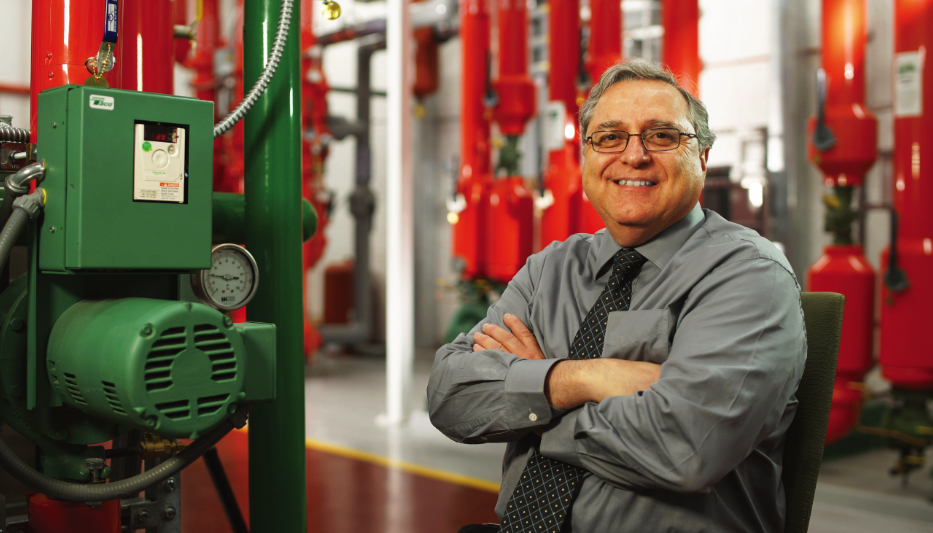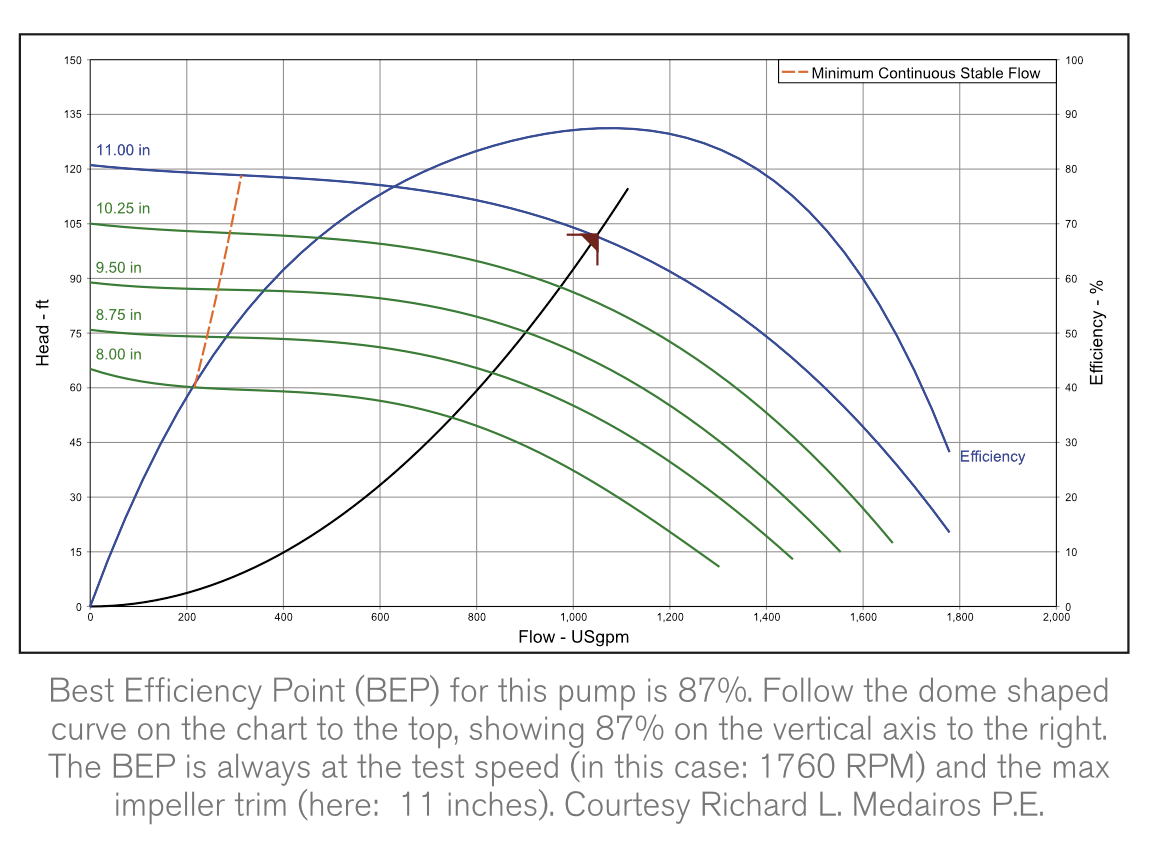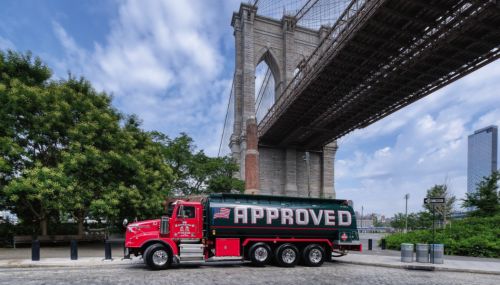All
Achieving Pump, and System, “Best Efficiency Point” Performance
by John Vastyan

Don’t let the tail wag the dog
Best Efficiency Point (BEP) is the point of the operations curve that is, simply, most efficient. Set the system operating too low, and there is not enough power to produce the desired result in a timely manner. Set it too high, and you expend too much energy. The “sweet spot” is the BEP.
There are many questions to be answered before determining the BEP of hydronic systems, beyond the equipment design. What’s the purpose of the building? Are there laboratories, a cafeteria, warehouse space? Is it dormant during the evening hours, or is it “alive” 24 hours a day as a hospital is? If it’s a dynamic building – with an active and mobile population – system needs will vary greatly.
I recently spoke with Richard Medairos, PE, senior systems engineer and trainer for Taco Comfort Solutions about determining and maintaining BEP. Over more than 40 years in the industry, Medairos has worked on projects for NASA’s Kennedy Space Center, Disney World, Universal Studios Florida, Boston University, Rhode Island School of Design, First Data Corporation, and now Taco’s Innovation & Development Center.
Medairos has been granted “hydronic sage” status within heating and engineering, and says that to optimize hydronic system configurations, we need first to consider the operating characteristics of the building. “To ask about pumps and system components without these insights is to let the tail wag the dog,” he insists.
Q: Rich, how can you determine what a building’s characteristics really are?
A: Ask: What’s the building’s intended use? Mechanically: is the design of environmental systems driven by cooling or heating needs? Does it have a migrating population? Is it owner-occupied, or a leased
facility?
Q: Let’s say that we’re designing a hydronic system for a 100,000 s.f. owner-occupied office facility in Buffalo. Influencing our choice of system design and pumping strategy is the owner’s interest in reducing operating costs and enhancing comfort with less emphasis on initial cost. What are your thoughts?
A: You’ve just told me a lot. As a system designer, I may now have the flexibility to specify hydronic heating and cooling systems and to apply a higher efficiency pumping solution as part of the design – with greatly more comfort and control than, say, a conventional all-air building.
Q: So, let’s say you’re granted the opportunity to design that hydronic heating and cooling system. How do you set out to achieve optimal system performance, or BEP?
A: I’d likely choose a primary/secondary/tertiary pumping solution for starters. I’d also choose a differential temperature or Delta T (ΔT) mode of operation for the pumps as opposed to differential pressure. The Delta T mode permits the system to closely match the dynamic characteristics of the building. Response – referring here to change in flow as the building calls for it – is faster and better matched to building load with a Delta T design. System flow is designed to optimally meet the two key needs: dynamic change and load change.
Q: Are multiple pumps more efficient within a commercial system than, say, one or two pumps sized to meet the load?
A: Multiple pumps are much more adept at responding to a need for change in flow than a few larger pumps. They’re also much more capable of maintaining optimal system performance. Let’s say the building owner is looking at a choice between the two or three pumps. The choice of three pumps may be a more expensive one on the front end, but the dividend paid by the “up-charge” would be quickly apparent in terms of comfort, control, system efficiency, the cost of operation and perhaps also in the lifespan of system components, including the pumps.
When a pump slows down, it loses efficiency. With multiple pumps, we can choose pumps matched precisely for the load, allowing each pump to operate frequently within its maximum efficiency “sweet spot,” an advantage that translates to high energy efficiency and best pump, and system, performance.

Q: Rich, let’s talk about further levels of system efficiency. What can you tell us about VFDs or ECM-driven, variable speed pumps?
A: Still new to many building owners is the emergence of “smart” or self-sensing pumps. So far, the super-high efficiency ECM pumps are limited by size, typically in the 2-1/2 to 10 HP range. If larger pumps are needed, pumps are matched with variable frequency drives (VFDs) to achieve ultra-high efficiency.
Let’s say, to meet the needs of the 100,000 s.f. office building in Buffalo, that we need hot water circulation of 300 gallons per minute (gpm). Let’s also assume we’ve determined that we can meet demand with two 7.5 HP pumps matched with VFDs; the pumps are sized to exactly meet maximum load. It’s important to note that pumps operate most efficiently at maximum load – they’re selected that way. Let’s add that the pumps are set for pressure differential (ΔP) operation.
Yet, professionals in the industry know from experience that design conditions are a rarity. In this case, the two 7.5 HP pumps may be sized to meet load needs, each pumping 50 percent of the load. Combined, they efficiently move the needed 300 gpm when ambient temperatures are -10°F, yet those conditions may be seen only three or four days a year.
As outside temperatures increase, the load decreases, and now the two pumps are operating at, say, 70 percent of their original speed. As they do, they lose operational efficiency.
A better plan would be to meet system needs with three 5.0 HP pumps, operating in the ΔT mode, and attached to correspondingly smaller VFDs. Pumped system designers have all learned that there’s a bit of ‘hydronic magic’ to the use of three pumps (or more) for larger volume applications.
Picture it: in stepped fashion, a system rather predictably moves from 1/3 capacity, to 2/3 to full and in each case, one pump – operating in its BEP sweet spot – can meet the need, or two pumps (also in their most efficient mode), or three pumps – at design conditions – merrily pump away while always much closer to their most efficient operational range.
Three pumps, each matched to closely achieve their BEP. That’s smart use of pumping horsepower and the energy needed to drive them.
John Vastyan owns Common Ground, a public relations firm based in Manheim, PA, specializing in the construction and HVAC industry.
Related Posts
 From Blue Flame to Biofuels
From Blue Flame to Biofuels
Posted on June 25, 2025
 HEAT Show Announces Fenway Park Backyard BBQ
HEAT Show Announces Fenway Park Backyard BBQ
Posted on May 15, 2025
 Delivering New York City’s Clean Energy Solutions
Delivering New York City’s Clean Energy Solutions
Posted on May 14, 2025
 Are You a Leader or a Boss? The Choice is Yours
Are You a Leader or a Boss? The Choice is Yours
Posted on May 14, 2025
Enter your email to receive important news and article updates.
